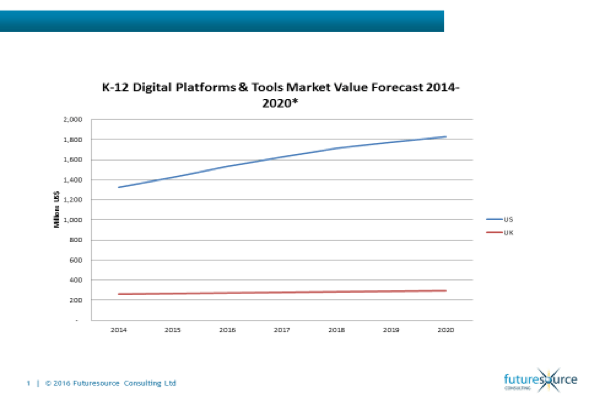The education technology landscape is rapidly evolving. The adoption of mobile PC’s in classrooms, the digitisation of content, a growing reliance on cloud services and a high penetration of smart devices amongst parents, teachers and students are just some of the catalysts for change. To accommodate an increasingly digital school environment, the platforms and tools market is evolving and growing with developments across both administrative and instructional technologies. The latest report from Futuresource’s Educational Technology team examines the digital platforms and tools markets for K-12 education in both the US and UK.

The report provides an overview of key sectors by illustrating market trends, notable suppliers, market value and growth expectations across the following categories:
- Student Information Systems
- Back Office Tools including ERP, Communications and Data Analytics Platforms
- Learning Management Systems
- Classroom Management & Collaboration Tools including Interactive Presentation, Classroom Response, Device Monitoring and Social Engagement Solutions.
As the diversity of solutions in use grows, end-users are demanding platform rationalisation and integration. As such, supply side consolidation and applications interoperability are key areas of development. The recent past has seen major US players like PowerSchool (Student Information Systems) & Blackboard (Communications & Learning Management) increase market exposure through the acquisition of complimentary and competitive solutions. “These companies are seeking to become holistic suppliers, leveraging the customer base of individual businesses to upsell a broader solution,” comments Ben Davis, Senior Market Analyst at Futuresource Consulting.
Data standards and integration solutions from providers like Ed-Fi, IMS Global and Clever are uniting the applications ecosystem, reducing operational burdens and creating new opportunities for high growth product segments like data analytics platforms. “This could have significant implications for procurement going forwards,” continues Davis. “With these tools used to identify strategies for student retention, analyse the ROI of investments and differentiate learning for students, analytics platforms have the capacity to influence school leadership at the highest levels.”
In the classroom, the increased utilisation of PC’s has spurred rapid growth for device management tools servicing both administrative and instructional requirements. Mobile device management software allows IT staff to centrally distribute applications and configure devices while classroom management and collaboration tools allow teachers to monitor the usage of devices and engage students via quizzing games and interactive presentations. “Market value in these segments is high growth, especially in the US, where the penetration of student devices is over 45%. Unlike other product segments (which are closely aligned to local curriculum and reporting standards), these solutions offer significant international growth opportunities. Companies in this space will be some of the most interesting to watch, going forwards, as the penetration of devices in international markets rises,” adds Davis.
The rise of freemium business models are another key takeaway from the report. This is most notable in the arena of instructional technologies, where there are already large user basis for tools enabling classroom communications, assignment distribution and student response. Providers show the capacity to displace and disrupt more traditional paid for solutions in areas like learning management and classroom response but some are struggling to monetise. “Some of these companies have amassed user basis into the tens of millions and attracted significant investment, but there is a clock ticking on the ability to turn a profit. Some are seeking to monetise in areas adjacent to the core product offering, but the most successful freemium approaches have come from companies able to monetise the core product after offering a free to access trial or ‘lite’ solution,” says Davis.


